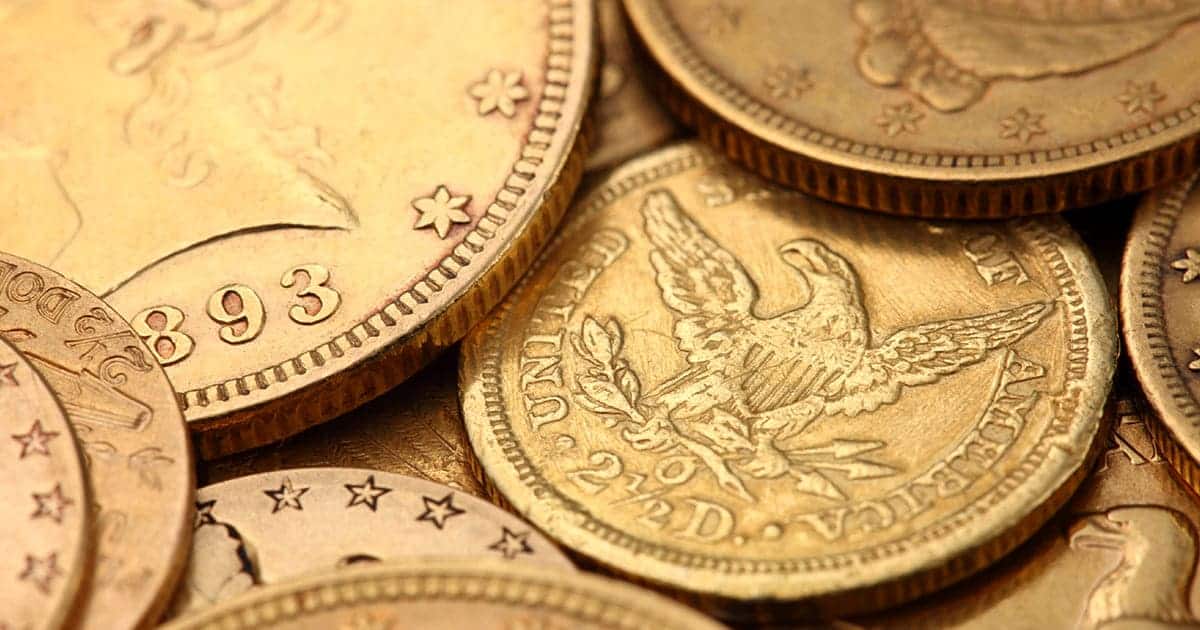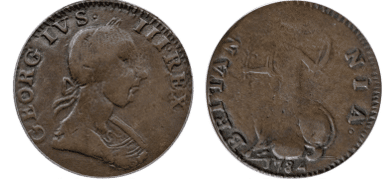
Learn About Machin’s Mills in New York, 1747 – 1788
In 1787 the New York legislature rejected the idea of opening a mint for the state of New York and also rejected the multiple offers they had before them from entrepreneurs to make coinage for the state. Thomas Machin was one of those people whose offer was rejected, but he was not about to be deterred and he formed a company with several partners to strike coins in any event.
Even without the proper authority to strike coinage for New York, they were otherwise very busy. They began by striking imitation (Counterfeit) British Halfpennies, which had continued to circulate even after the Revolutionary War was over. But how they made money was not perfectly legal. The coins that Machin and his colleagues struck were underweight. They took in old British Half Pennies for their services and paid out their obligations using their new lightweight imitations.
The counterfeit British Half Pennies are identified by the very thick lips of King George III on the obverse or by the large, triangular-shaped denticles on the edge of the coin. Many of the Machin’s Mills coins bore the obverse “GEORGIUS III.” and rev. “INDE ET LIB.” Others bore the figure of a plow on one side.
As the private mints in Connecticut, New Jersey and Vermont began to fail, Machin would buy up their presses and other equipment and most of it was used at Machin’s Mills. Along with their “imitation British halfpence,” the midnight minters at Machin’s Mills also produced a number of counterfeit Connecticut coppers as well as some legal Vermont Coppers. Most of the legal Vermont coins struck by Machin were struck over counterfeit Irish halfpennies. The minting (legal and otherwise) continued at the Machin’s Mills facility until 1791. That is longer than the legally authorized mints for Connecticut, New York and Vermont were in operation.
Machin’s Mills produced 14 different types of “imitation” British Half Pennies as follows:
- 1747 GEORGIVS II. These coins bore the early date of 1747 and had a bust of George II facing left on the obverse with “GEORGIVS II. REX.” around the periphery. The reverse had Britannia facing left, with “BRITANNIA” around the periphery.

2. 1771 GEORGIVS III. The obverse has a bust of George III facing right with “GEORGIVS. III. REX.” on the obverse and Brittania seated, facing left and “BRITANNIA” on the reverse.

3. 1772 GEORGIVS III. Same as above but dated 1772 on the reverse instead of 1771.

4. 1772 GEORGIUS III. Same as above but “GEORGIUS” on obverse instead of “GEORGIVS”.

5. 1774 GEORGIVS III. The obverse depicts King George III, facing right with “GEORGIVS. III. REX.” The reverse has a seated Britannia facing left with “BRITANNIA” around.

6. 1774 GEORGIUS III. Same as above but “GEORGIUS” on the obverse.

7. 1775 GEORGIVS III. The obverse depicts King George III, facing right with “GEORGIVS. III. REX.” The reverse has a seated Britannia facing left with “BRITANNIA” around.

8. 1776 GEORGIVS III. Same as above but the date on the reverse is 1776.

9. 1776 GEORGIVS III, SMALL DATE. Same as above, but the date is small in size. RARE!

10. 1778 GEORGIVS III. The obverse depicts King George III, facing right with “GEORGIVS. III. REX.” The reverse has a seated Britannia facing left with “BRITANNIA” around and the 1778 date.

11. 1784 GEORGIVS III. Same as above but with 1784 date on the reverse. The portrait is somewhat modified and less “regal.”

12. 1787 GEORGIVS III. The obverse depicts King George III, facing right with “GEORGIVS. III. REX.” The reverse has a seated Britannia facing left with “BRITANNIA” around and the 1787 date.

13. 1787 GEORGIVS III. Same as above but over 1777 date.

14. 1788 GEORGIVS III. The obverse depicts King George III, facing right with “GEORGIVS. III. REX.” The reverse has a seated Britannia facing left with “BRITANNIA” around and the 1778 date.

Only the 9th and 11th major types are expensive. While no mintages are available, it is believed that the mintage for most types is between 5,000 – 10,000 coins. Most surviving specimens are well-worn due to years of circulation.
| Date | Type | Mintage | Good Value | XF Value |
| 1747 | GEORGIVS II | Unknown | $400 | $9,000 |
| 1771 | GEORGIVS III | Unknown | $400 | $9,000 |
| 1772 | GEORGIVS III | Unknown | $400 | $6,500 |
| 1772 | GEORGIUS III | Unknown | $250 | $5,000 |
| 1774 | GEORGIVS III | Unknown | $150 | $4,000 |
| 1774 | GEORGIUS III | Unknown | $300 | $7,000 |
| 1775 | GEORGIVS III | Unknown | $150 | $4,000 |
| 1776 | GEORGIVS III | Unknown | $250 | $7,500 |
| 1776 | GEORCIVS III | Unknown | $2,500 | $30,000 |
| 1778 | GEORGIVS III | Unknown | $100 | $2,150 |
| 1784 | GEORGIVS III | Unknown | $500 | $7,000 |
| 1787 | GEORCIVS III | Unknown | $100 | $1,350 |
| 1787 | GEORGIVS III | Unknown | $100 | $1,350 |
| 1788 | GEORGIVS III | Unknown | $125 | $3,000 |
Expand your collection today and shop our assortment of rare coins and currency.




